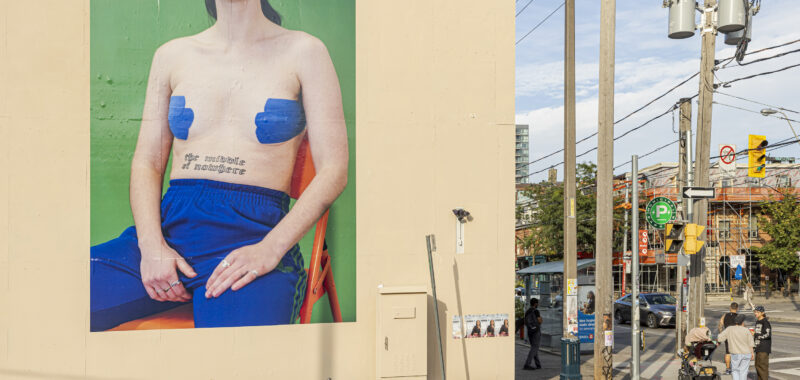TORONTO — Aptly titled Precarious Joys, the third edition of the Toronto Biennial of Art (TBA) casts its gaze on this moment of global political turmoil and the fragile state of the world. Curated by Dominique Fontaine and Miguel A. López, the exhibition, spread across 11 venues around the city, brings together more than 35 artists and collectives from Canada via the Caribbean and Asia, from Latin and South America, and across the globe, to reflect on pressing social, political, and ecological issues such as land preservation, the relationships between beings and places, wastelands, resistance, identity, and movement. The Biennial is premised on six key directives that artists cited in a series of dialogues with curators: joy, precarity, home, polyphony, solace, and “coded” (as in expressing themselves in an indirect way). Through these terms, the exhibition “encapsulates how the artists’ practices amplify political consciousness and the power of aesthetics in shaping collective life,” as per Fontaine and López’s curatorial statement.
Tong Yan Gaai (or Chinatown in Cantonese) (2012–24), Morris Lum’s lightbox photo series highlighting Toronto’s Chinese community, greets visitors at the city’s Union Station and Pearson Airport. The Canadian railway was a major component in the creation of many of the country’s Chinatowns; Lum’s works, incorporating archival images, vividly portray what TBA aims to present: a world containing layered histories of immigration, migration, and belonging that emphasize community building and collective life.

Larger-than-life works such as Léann Herlihy’s “to be nowhere” (2022), a billboard at Abell Street and Queen Street West (part of an ongoing photography series), and Rajni Perera’s sculpture “Vimana (N1 Starfighter)” (2024), installed at the Toronto Sculpture Garden, address the topic of space. While Herlihy centers queer and trans experiences to express how these communities occupy and transform space through a massive self-portrait showing their bound chest, Perera’s modern rendition of a spacecraft made of bamboo and rice paper lanterns confronts Western conceptions of advanced aerospace technology through immigration and space travel by fusing science fiction with traditional Buddhist Vesak kūdu.
Group exhibitions held at Auto BLDG, 32 Lisgar Street, and Collision Gallery demonstrate the sustained dialogue between artists and curators that is part of collectivity in the arts. At Collision Gallery, Tessa Mars (“All Islands Touch,” 2024) and Rajni Perera (“Joyous Procession / Infinite Serpent,” 2024) present paintings addressing displacement due to the devastation of ecosystems. Both works portray morphed humans moving through an incongruous landscape, where air, earth, and water are no longer as clearly delineated as what we navigate today. Ahmed Umar’s “Truth Bears No Scandal (الـواضِح مو فـاضِح)” (2024) and Citra Sasmita’s “Timur Merah Project XII: Light Speed and Revelation” show how the past invariably coexists with the present. Umar revisits classic Sudanese songs written about same-sex lovers and injects joy and fun to queer stories that would otherwise be violently criminalized. Suspended in the middle gallery, the installation, comprised of paintings on traditional Kamasan canvas, neon lamps, and python snakeskin, articulates how Balinese myths have the same relevance as modern Western truths.

Upon entering the ninth floor of the old Northern Aluminum Company, highly crafted textile installations seamlessly cohabit with photography and installations. For “I Lay My Ear Against the Weave’s Ear” (2019–ongoing), Elina Waage Mikalsen transformed her grandmother’s loom to create new instruments. Dismantled into a harp-like instrument, it will be activated by the artist playing it with rocks and adding her voice. It is her way to explore friction and connection between heritage, representation, power relations, and identity formation. Stina Baudin also uses the loom as a communication device, translating data to visualize transient conditions. In “Data Studies: Caribbean-Canadian Geographies 86/96” (2022), a colorful weaving suspended on a white wall piece deciphers data to point to migratory conditions of the Black diaspora, information that, as Baudin says, we are accustomed to accessing on a computer.
Artists also took advantage of 32 Lisgar Street’s odd shape and enclosed rooms to present powerful videos and immersive installations, and provide a space of rest for the public. These works, and those in the various biennial venues around Toronto, speak of the reverberating effects of colonization, signs of resistance, unmasking, rituals, history, and erasure, all subjects that expand understandings of the six keywords highlighted by the artists and curators.
This edition of TBA is imbued with the awareness that time is not given: if we can spare it, we can take our time with each work, letting its joys, stories, and multitudes permeate us. Offering various perspectives on world-building to viewers, Precarious Joys demonstrates the potential of aesthetics and beauty to preserve collective histories and memories cut short by neoliberalism and imperialism. We can make a home through scarcity and find merriment and beauty amid instability.

(2024), on view at Collision Gallery as part of the Toronto Biennial of Art, 2024; commissioned by the Toronto Biennial of Art (courtesy the artist and OSL Contemporary)





The Toronto Biennal of Art: Precarious Joys continues in various venues around Toronto through December 1. It was curated by Dominique Fontaine and Miguel A. López.

